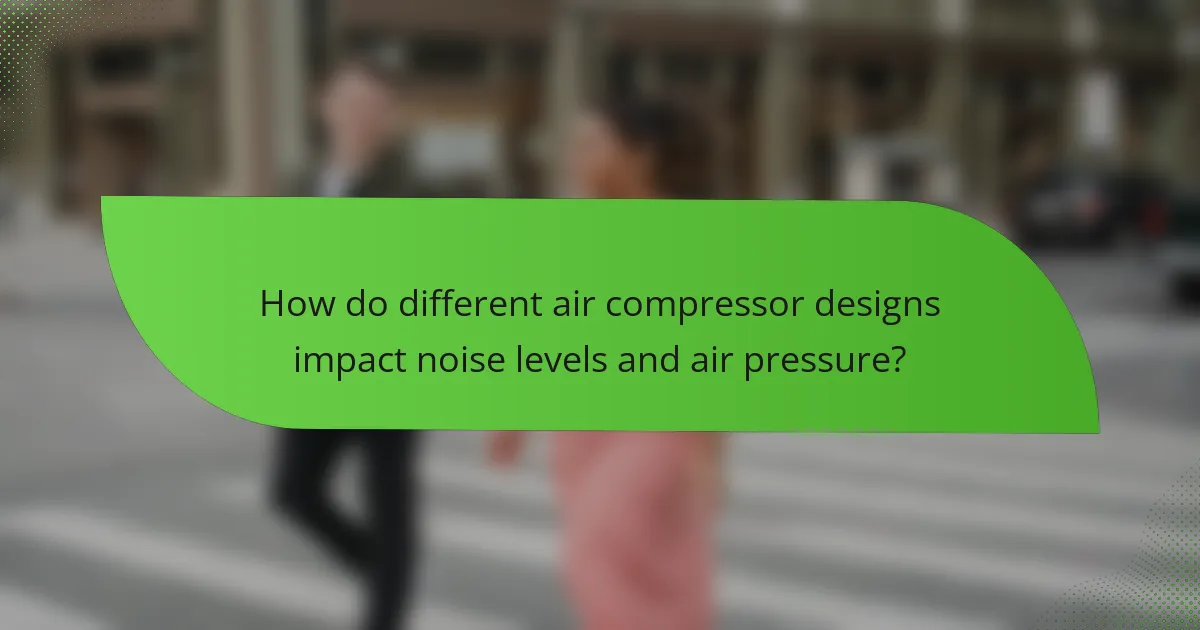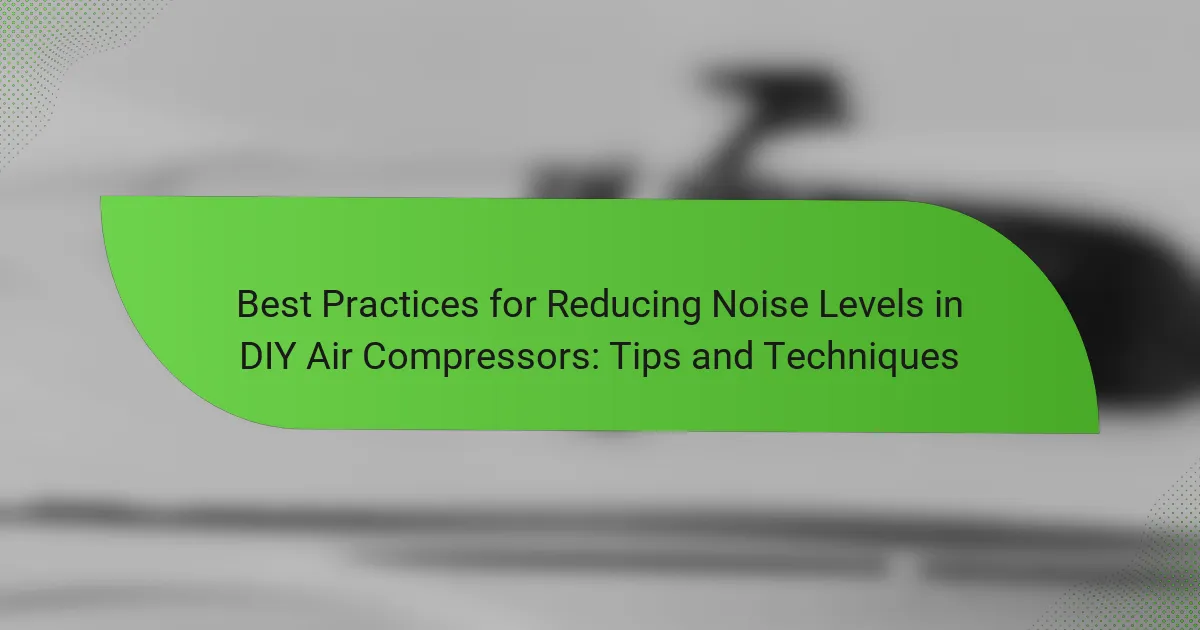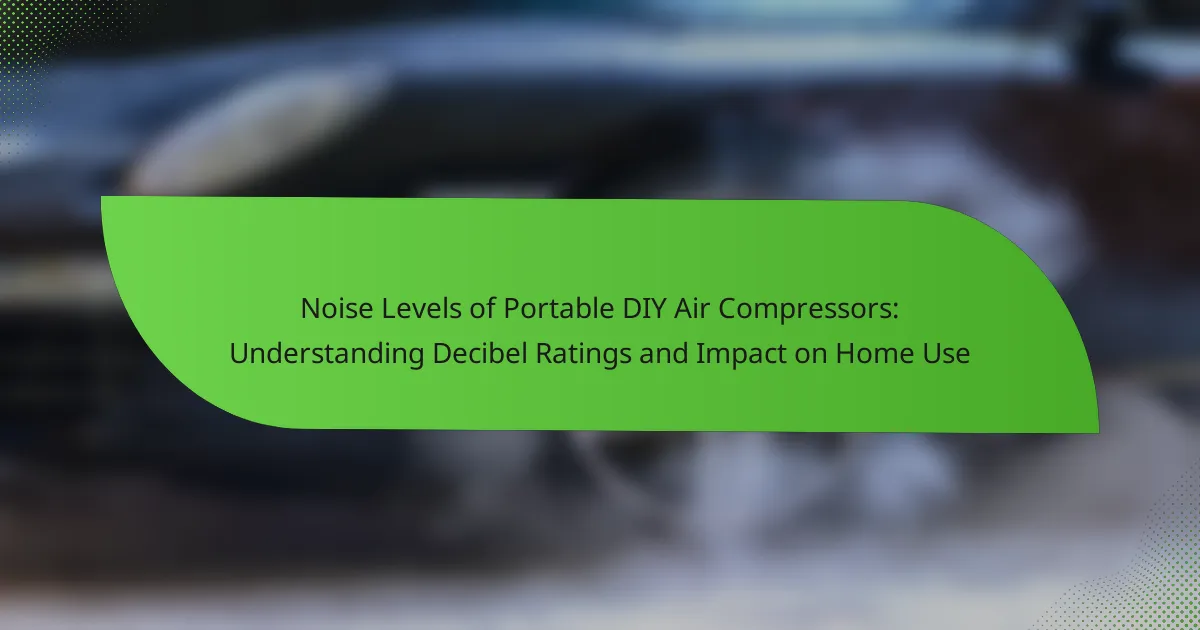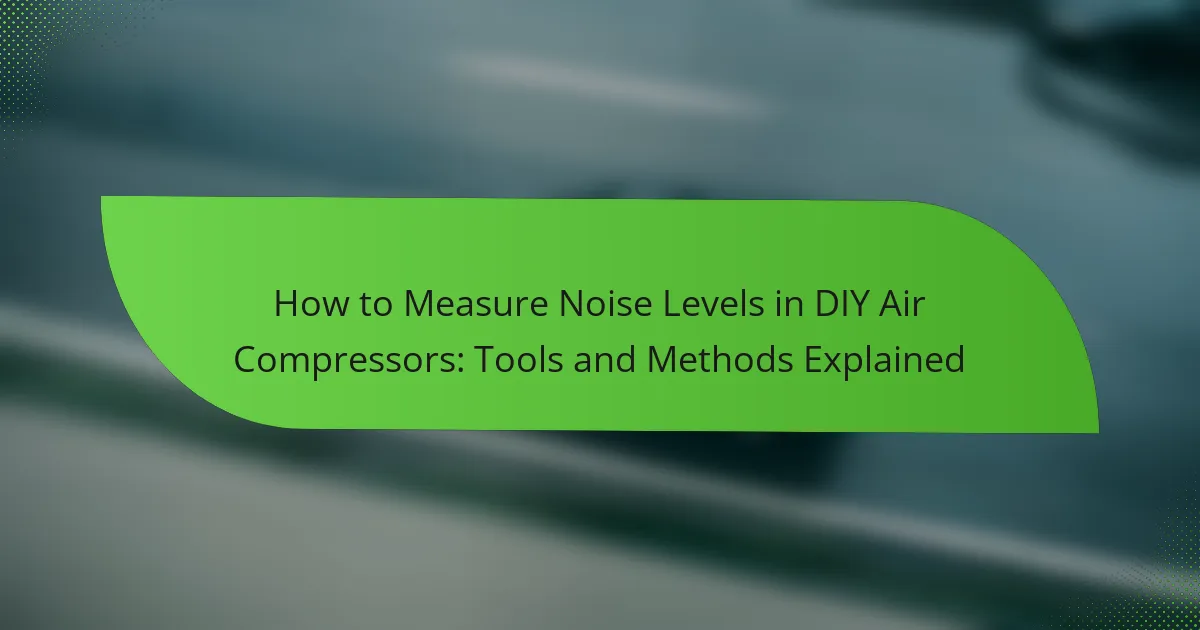DIY air compressors are essential tools that generate compressed air for various applications, but their noise levels are significantly influenced by air pressure. As air pressure increases, the compressor’s motor works harder, resulting in elevated noise levels, often exceeding 90 decibels. Different compressor designs, such as reciprocating and rotary screw compressors, impact both noise output and air pressure stability, with rotary designs generally being quieter. Effective noise management can be achieved through soundproofing materials, proper maintenance, and pressure regulation, allowing users to balance performance with acceptable noise levels. Understanding these relationships is crucial for selecting the right air compressor for specific needs.

What is the relationship between noise levels and air pressure in DIY air compressors?
Noise levels in DIY air compressors generally increase with higher air pressure. This is due to the mechanics of compression and airflow. As air pressure rises, the compressor’s motor works harder, producing more noise. Additionally, higher pressure can lead to increased turbulence in the airflow, which contributes to sound generation. Research indicates that sound levels can exceed 90 decibels at high pressures, making it crucial for users to consider both pressure settings and noise reduction measures.
How do noise levels in DIY air compressors affect user experience?
Noise levels in DIY air compressors significantly affect user experience. High noise levels can lead to discomfort and distraction for users. Studies show that compressors operating above 85 decibels can cause hearing damage over time. Users may also experience increased stress and fatigue due to loud environments. Low noise levels, typically below 70 decibels, create a more pleasant working atmosphere. This can enhance focus and productivity during tasks. Additionally, quieter compressors are often preferred for residential use to minimize disturbances. Therefore, noise levels play a crucial role in determining user satisfaction and overall experience with DIY air compressors.
What factors contribute to the noise levels in DIY air compressors?
Factors contributing to noise levels in DIY air compressors include motor type, compressor design, and vibration. The motor type affects noise; for instance, induction motors are generally quieter than universal motors. Compressor design plays a significant role; oil-lubricated compressors tend to operate more quietly than their oil-free counterparts. Additionally, vibrations from the compressor can amplify noise levels. Proper mounting and isolation can reduce vibrations and, consequently, noise. The size and speed of the compressor also influence noise; larger, faster compressors often generate more sound. Lastly, the presence of sound-dampening materials can mitigate overall noise levels.
How does air pressure influence the operational noise of air compressors?
Air pressure significantly influences the operational noise of air compressors. Higher air pressure typically leads to increased noise levels. This increase occurs due to the greater energy required to compress air at higher pressures. Additionally, higher pressure can result in faster-moving components within the compressor. These faster-moving parts generate more vibration and, consequently, more noise. Studies indicate that every increase of 10 psi in air pressure can raise noise levels by approximately 2 dB. Therefore, managing air pressure is crucial for controlling noise in air compressor operations.
Why is understanding this relationship important for DIY enthusiasts?
Understanding the relationship between noise levels and air pressure is crucial for DIY enthusiasts. This knowledge helps in selecting the right air compressor for specific projects. Lower noise levels can enhance the working environment, making it more comfortable. Additionally, understanding how air pressure affects noise can lead to quieter operation. DIY enthusiasts can use this information to minimize disturbances in residential areas. Moreover, it aids in optimizing compressor performance for tasks requiring different pressure levels. Knowing this relationship also allows for better maintenance practices, prolonging the compressor’s lifespan. Overall, it empowers DIY enthusiasts to make informed decisions for effective and enjoyable projects.
What are the implications of noise levels on project environments?
Noise levels in project environments can significantly impact productivity and worker well-being. High noise levels can lead to increased stress and fatigue among workers. Research indicates that prolonged exposure to noise can reduce concentration and lead to mistakes in tasks. For instance, a study by the National Institute for Occupational Safety and Health found that noise exposure can diminish cognitive performance. Additionally, excessive noise can hinder communication, leading to misunderstandings and safety risks. Maintaining acceptable noise levels is crucial for creating a conducive work environment. Effective noise management can enhance focus and overall project outcomes.
How can knowledge of air pressure and noise levels improve compressor performance?
Knowledge of air pressure and noise levels can significantly improve compressor performance. Understanding optimal air pressure settings allows for efficient operation. Compressors function best within specific pressure ranges. Operating outside these ranges can lead to inefficiencies and increased wear.
Noise levels can indicate mechanical issues or inefficiencies. High noise levels often correlate with malfunctioning components. Monitoring noise can help identify problems early, preventing costly repairs.
Research shows that maintaining optimal air pressure can enhance energy efficiency by up to 20%. Lower noise levels can also improve user experience and safety. Thus, knowledge of both factors is crucial for maximizing compressor effectiveness.

How do different air compressor designs impact noise levels and air pressure?
Different air compressor designs significantly impact noise levels and air pressure. Reciprocating compressors tend to produce higher noise levels due to their mechanical movement. They often operate at higher pressures, typically between 90 to 150 psi. In contrast, rotary screw compressors are generally quieter. They operate more smoothly and can maintain consistent air pressure with less fluctuation.
The design of the compressor influences sound insulation capabilities. Enclosed designs can reduce noise output significantly. For example, some rotary compressors can operate at noise levels as low as 60 dB. This is much quieter than reciprocating compressors, which can reach levels of 85 dB or more.
Additionally, the air pressure output is affected by the compressor’s design. Higher pressure ratings are often linked to increased noise levels. Therefore, selecting a compressor design involves balancing the need for air pressure with acceptable noise levels.
What are the common types of DIY air compressors?
The common types of DIY air compressors include reciprocating, rotary screw, and diaphragm compressors. Reciprocating compressors utilize pistons to compress air. They are often used for small projects and are relatively inexpensive. Rotary screw compressors use two screws to compress air continuously. They are suitable for larger applications and provide a steady air supply. Diaphragm compressors use a diaphragm to compress air and are typically quieter. Each type has distinct noise levels and pressure outputs, impacting their suitability for various DIY tasks.
How does the design of a piston compressor affect noise and pressure?
The design of a piston compressor significantly influences both noise levels and pressure output. A well-engineered piston design can minimize vibration, which directly reduces noise. For instance, using a balanced crankshaft and proper mounting can lead to quieter operation. Additionally, the cylinder shape and materials affect how sound waves propagate.
Pressure is influenced by the piston stroke length and diameter. A longer stroke can increase pressure output by compressing air more effectively. The clearance volume in the cylinder also plays a role; reducing this volume can enhance efficiency and pressure consistency.
Research shows that compressors with optimized designs can achieve lower decibel levels while maintaining higher pressure outputs. For example, a study published in the Journal of Sound and Vibration highlights that noise levels can be reduced by up to 10 dB with specific design modifications.
What role does the tank size play in noise levels and air pressure stability?
Tank size directly influences noise levels and air pressure stability in DIY air compressors. Larger tanks typically allow for more air storage, which leads to fewer compressor cycles. This results in lower noise levels since the compressor runs less frequently. Additionally, a larger tank provides a more stable air pressure by reducing fluctuations during operation. The increased volume helps maintain consistent pressure, minimizing the risk of pressure drops. Studies show that compressors with larger tanks can operate at lower decibel levels compared to smaller tanks. Thus, tank size plays a crucial role in both noise reduction and air pressure consistency.
How do materials used in construction influence noise levels?
Materials used in construction significantly influence noise levels. Different materials absorb, reflect, or transmit sound in varying degrees. For instance, concrete and brick have high mass and density, which can block sound transmission. In contrast, lightweight materials like drywall may allow more sound to pass through. Additionally, insulation materials can reduce noise by absorbing sound waves. According to the National Institute of Standards and Technology, sound absorption coefficients vary widely among materials. This means that the choice of construction materials directly impacts the overall acoustic environment.
What materials are commonly used in DIY air compressors?
Common materials used in DIY air compressors include metal, plastic, and rubber. Metal is often used for the tank and frame due to its strength and durability. Aluminum is a popular choice for its lightweight properties. Plastic components are frequently used for housing and fittings because they are corrosion-resistant. Rubber is commonly found in seals and hoses to ensure airtight connections. These materials collectively contribute to the effectiveness and longevity of DIY air compressors.
How does insulation help reduce noise in air compressors?
Insulation helps reduce noise in air compressors by absorbing sound waves. This absorption minimizes vibrations that would otherwise escape into the environment. Insulation materials, such as foam or fiberglass, are effective at dampening noise. They create a barrier that prevents sound transmission. Studies show that properly insulated compressors can reduce noise levels by up to 10 decibels. Lower decibel levels lead to a quieter working environment. Insulation also enhances the efficiency of the compressor by maintaining temperature. This combination of benefits makes insulation a key factor in noise reduction.

What are the best practices for managing noise and air pressure in DIY air compressors?
To manage noise and air pressure in DIY air compressors, use soundproofing materials. Insulating the compressor with foam or acoustic panels can significantly reduce noise levels. Additionally, maintaining proper air pressure is crucial. Regularly check and adjust the pressure settings according to the manufacturer’s specifications. Installing a pressure regulator can help maintain consistent air pressure. Furthermore, place the compressor on a stable surface to minimize vibrations that contribute to noise. Using vibration isolators can also dampen sound transmission. Lastly, ensure regular maintenance of the compressor to prevent excessive noise from mechanical issues. Following these practices can enhance performance and reduce noise levels effectively.
How can users effectively reduce noise levels in their compressors?
Users can effectively reduce noise levels in their compressors by implementing soundproofing measures. Installing acoustic panels around the compressor can absorb sound waves. Using rubber pads or vibration isolators can minimize vibrations that contribute to noise. Enclosing the compressor in a soundproof box can further contain the noise. Regular maintenance, such as lubricating moving parts, can also reduce operational noise. Additionally, selecting a compressor designed for quieter operation can significantly lower noise levels. Research indicates that soundproofing can reduce noise by up to 50%.
What modifications can be made to decrease operational noise?
To decrease operational noise in DIY air compressors, several modifications can be implemented. Adding sound insulation around the compressor can significantly reduce noise levels. Using rubber mounts or vibration isolators can minimize vibrations that contribute to noise. Enclosing the compressor in a soundproof cabinet can also help contain and reduce noise emissions. Installing a quieter motor or replacing the compressor with a low-noise model can further decrease operational noise. Additionally, regular maintenance can ensure that components are functioning optimally, which can prevent excessive noise from wear and tear. These modifications are supported by research indicating that sound insulation and vibration reduction techniques effectively lower noise levels in mechanical systems.
How can proper maintenance influence noise and pressure management?
Proper maintenance can significantly reduce noise and enhance pressure management in DIY air compressors. Regular maintenance ensures optimal functioning of components such as valves and filters. Well-maintained compressors operate more efficiently, producing less noise. For instance, lubricating moving parts minimizes friction, which in turn lowers operational noise levels. Additionally, maintaining proper air pressure helps prevent excessive noise caused by pressure fluctuations. Regular checks on air leaks can also enhance pressure stability. According to a study by the American Society of Mechanical Engineers, well-maintained compressors can operate up to 20% quieter. This illustrates the direct correlation between maintenance practices and effective noise and pressure management.
What troubleshooting tips can help users optimize air pressure and noise levels?
To optimize air pressure and noise levels in DIY air compressors, users should regularly check and adjust the pressure settings. Maintaining the correct PSI level can significantly reduce noise output. Users should also inspect for leaks in hoses and fittings, as leaks can cause the compressor to work harder, increasing noise. Additionally, placing the compressor on a stable, vibration-absorbing surface can minimize sound transmission. Regular maintenance, such as changing the oil and cleaning filters, ensures efficient operation, which can lower noise levels. Lastly, consider using sound-dampening enclosures to further reduce noise.
What common issues lead to increased noise levels in air compressors?
Common issues that lead to increased noise levels in air compressors include worn-out components, improper maintenance, and design flaws. Worn-out parts, such as bearings and pistons, can create excess vibration and noise. Lack of lubrication can also cause friction, resulting in louder operation. Improper mounting can amplify sound, as vibrations transfer to the surrounding structure. Additionally, design flaws, like inadequate sound insulation, contribute to higher noise levels. Regular maintenance can mitigate these issues, ensuring quieter performance.
How can users identify and resolve air pressure inconsistencies?
Users can identify air pressure inconsistencies by regularly checking the pressure gauge on their DIY air compressor. A significant deviation from the desired pressure indicates an inconsistency. Users should also listen for unusual noises during operation, as they can signal pressure issues. Inspecting hoses and connections for leaks is essential, as leaks can cause pressure drops. Additionally, users can perform a pressure test by blocking the output and monitoring the gauge for pressure loss over time. To resolve inconsistencies, users should tighten any loose fittings and replace damaged hoses. Regular maintenance, including checking the compressor’s oil level and filters, can prevent future issues. Maintaining proper pressure levels is crucial for optimal performance and noise reduction in air compressors.
The main entity of this article is DIY air compressors, with a focus on the relationship between noise levels and air pressure. The article examines how increased air pressure correlates with higher noise levels due to mechanical and airflow dynamics, emphasizing the impact on user experience and project environments. It discusses various factors influencing noise, including compressor design, motor type, and maintenance practices, while also highlighting best practices for managing noise and air pressure. Additionally, it addresses common issues that lead to increased noise and offers troubleshooting tips to optimize performance and user satisfaction.



